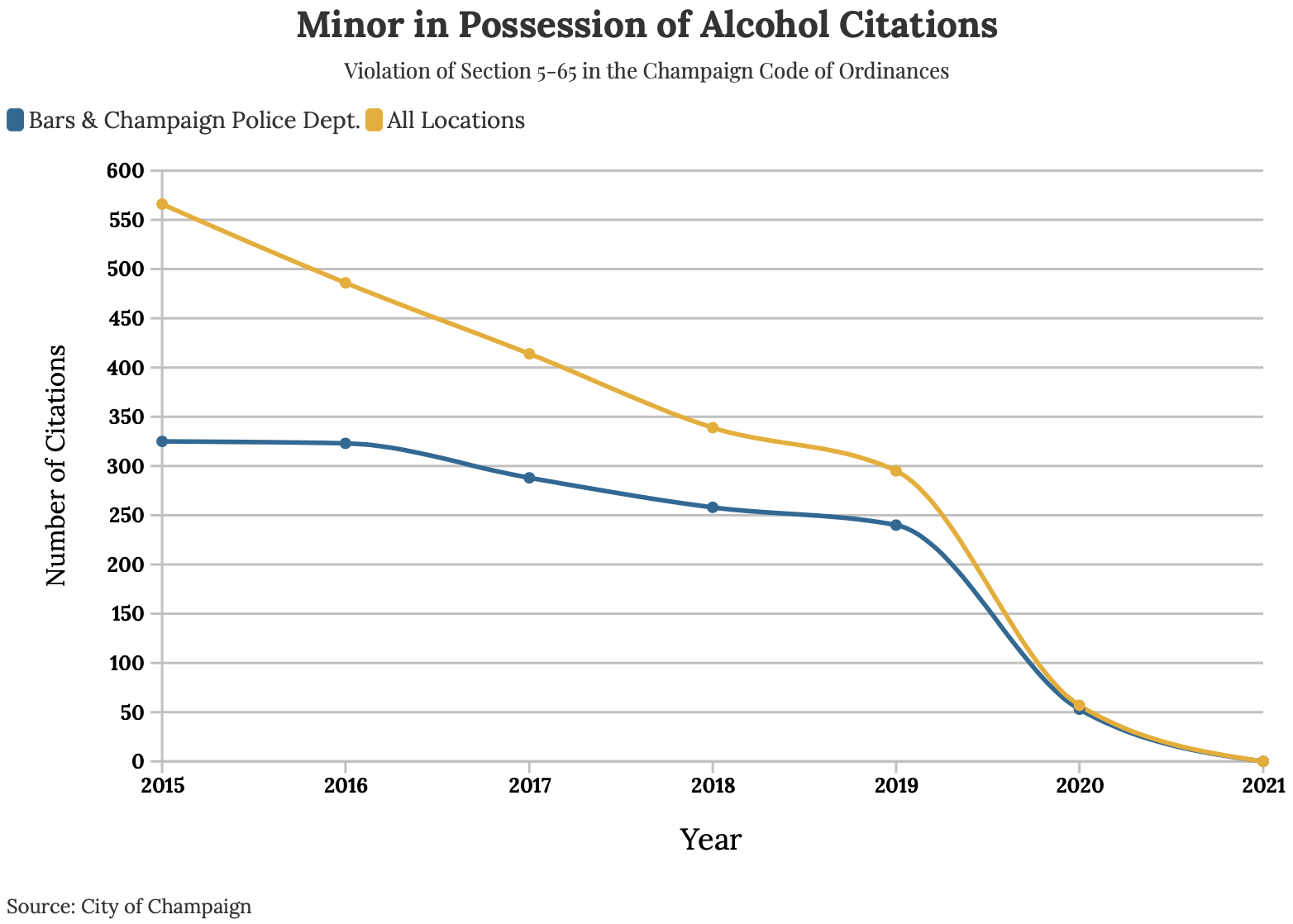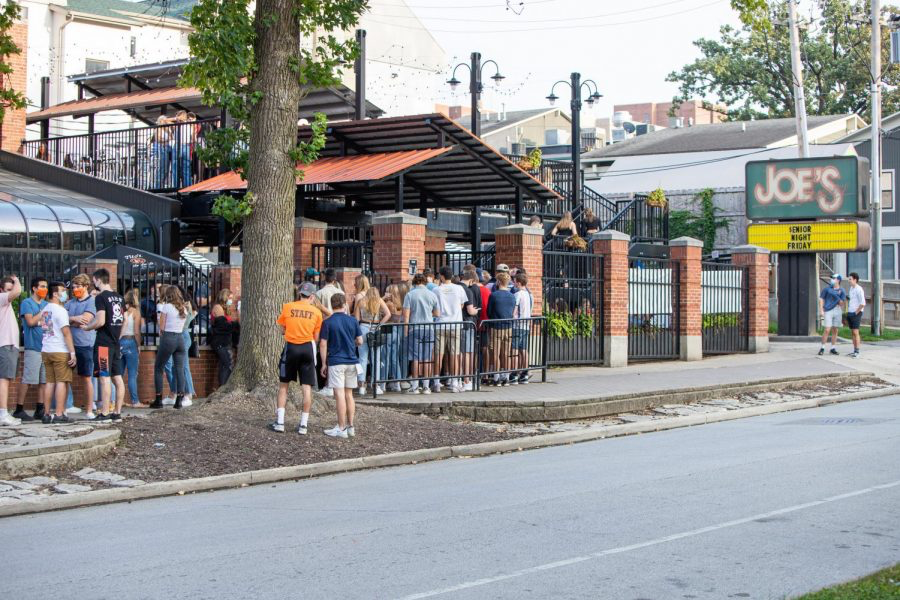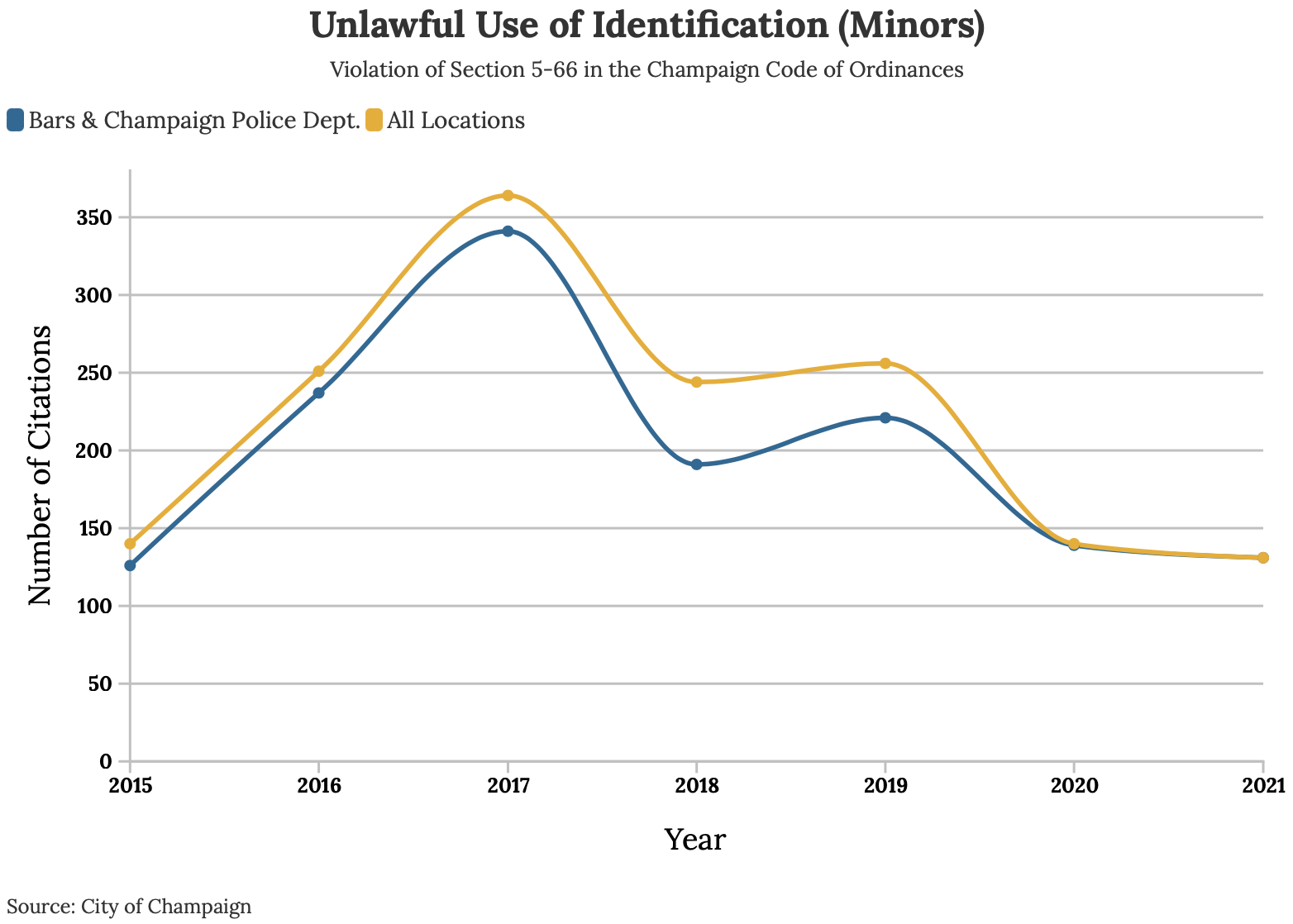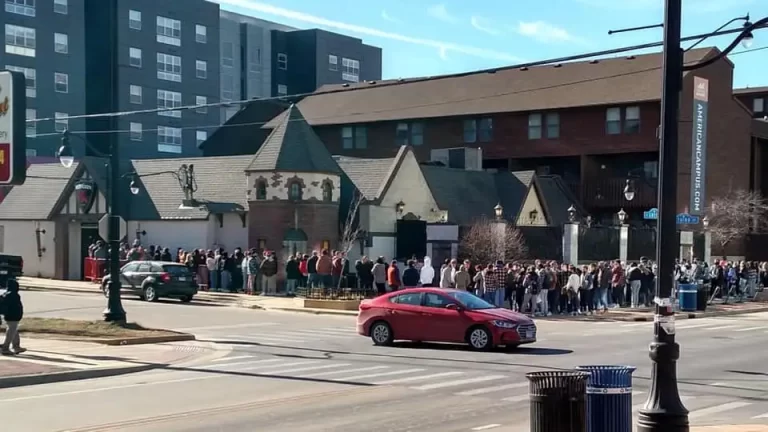It’s no secret that some underage students at the University of Illinois like to drink at nearby Campustown bars, and that those under 21 have ample opportunity to violate the law at Campustown bars.
But throughout the COVID-19 pandemic, the Champaign Police Department has made it even easier for minors to get away with underage drinking at the local campus bars.
In the past year and half, students have not had to worry about getting fined for drinking. Police have not fined a student since September 26, 2020. Students have been caught with fake IDs however.
The city allows students 19 and 20 years old into the bars where they are allowed to fraternize with friends, but not touch a drink.
In the past they have faced fines of $350 from Champaign police if they are caught drinking alcohol. The number of fines for underage drinking peaked in 2015 with 566 citations, which brought in $192,440 in city revenue. 2017 had the highest amount of fake ID citations, a total of 364, and brought in $127,400.

According to Deborah Feinen, mayor for the City of Champaign, the police department has lost around 25 police officers in the past year. 125 officers are needed in order to be fully-staffed, but only 100 sworn officers are currently available for duty.
Additionally, with the exponential increase in shooting incidents and other serious crimes in the vicinity of the University’s campus, popular bars among undergraduate students aren’t being checked as often in comparison to previous years.
“I don’t mean to minimize it, but 20-year-olds having a beer at a campus bar pales in comparison to some of the other things going on and where officers need to focus their attention, like on the gun violence issue,” said Mayor Feinen.
Bars favored by undergraduate students are located in the area known as Campustown in Champaign, which include The Red Lion, KAMS, Joe’s Brewery, Brothers Bar & Grill, Murphy’s Pub, Legends and the Illini Inn.

“Throughout most of 2020, we were focused on COVID-19 enforcement more than underage drinking enforcement,” Feinen said. “Most, if any, of the citations that were bar-related were about making sure people had their masks on and were complying with the new rules.”
Furthermore, on July 2, 2020, Feinen issued Emergency Order 20-24, which temporarily set the entry age to 21 and over for all Class A liquor license bars in Campustown. The order wasn’t lifted until the beginning of fall 2021.
Prior to the pandemic, Feinen said the Illinois State Police would oftentimes come to the campus area to help the Champaign police with conducting bar checks and issuing citations. This year, however, the state police department also hasn’t had as many resources available to help Champaign with traditional bar enforcement.
Lieutenant Andre Davis, east district commander for the Champaign police, said in terms of recruiting new officers and retaining current officers, there’s been a lack of interest in the law enforcement profession and staff numbers have consequently taken a major hit.
This predicament has thus impacted what current officers can do operationally regarding liquor enforcement at the Campustown bars.
“The name of the game here is resource allocation and being as surgical with our resources as we possibly can,” said Lieutenant Davis. “We realize that liquor enforcement is important, so right now the key is just to be creative in terms of what we can do from a resource allocation standpoint to address underage drinking issues that have always been there and will continue to be there.”
History of UIUC’s bar culture
When Illinois State law was revised in 1973 and started allowing 19-year-olds to drink beer and wine, the bar scene at the University of Illinois thrived ever since.
But in 1984, the National Minimum Drinking Age Act was passed and prohibited individuals under 21 from possessing or purchasing alcohol “as a condition for federal highway funding,” according to the Illinois Criminal Justice Information Authority.
At-large Champaign City Council member Tom Bruno said he thinks the United States is heading down the wrong path by keeping the legal drinking age at 21.
“At 18 years old, you can legally buy a car, take out a loan, enter into a home mortgage, get married, go to war, and represent yourself in a courtroom,” said Bruno. “But you can’t have a beer. I just think that’s unrealistic and bad policy.”
Bruno further said that the city council has maintained the minimum bar entry age at 19, despite not being able to legally purchase a drink, so underage students can still socialize with their friends in a public establishment instead of at an apartment or dorm. If a student were to get themselves into a life-threatening situation, such as an alcohol overdose, more people would be around in a bar to call an ambulance and get help, he added.
“With social peer pressures being as they are, older students can still purchase alcohol and provide it to younger students who are their academic peers and classmates,” Bruno said. “Plus, some students may be a long way from home and don’t have constant parental supervision, so they will continue to drink even when it’s illegal. So, the question becomes: Where do we want that happening?”
“Do we want underage students to drink in the backseat of a car? Or in somebody’s apartment where they might over consume alcohol and choke on their own vomit, get in a fistfight, or be sexually assaulted? Or do we want that to happen in a campus bar?” Bruno said.
The Champaign City Council has grappled with this issue for years, according to Mayor Feinen, but their concerns about private parties and students being unmonitored outweighs the younger entry age for the bars.
“They’re not supposed to be drinking. They’re only allowed to be present in the bars,” Feinen said. “Bar owners and staff are responsible for enforcing their policies and making sure that kids under 21 don’t drink.”
After several attempts, KAMS, The Red Lion, and Joe’s Brewery have declined to comment about their policies for preventing underage drinking.
Alcohol fines and their contribution to city revenue
Regardless of the city council’s reasoning for allowing 19- year- olds into bars, the fine amounts for alcohol-related ordinance violations seem to tell a different story.
As indicated in the Champaign Code of Ordinances, if individuals under 21 are caught with an alcoholic drink in hand or using a fake ID, they could face a minimum fine of $350.

Even though there weren’t any citations for underage drinking in 2021, data from the City of Champaign shows that students are still getting caught for using fake IDs.
In 2020 and 2021, a total of 271 citations were issued to minors using an unlawful ID. This means that in just these two years, if every offender paid their ticket within the allocated 21 days from the issuance data, the City of Champaign made a minimum of $94,850.
In 2017, which is the year with the highest number of fake ID citations at 364, the city would’ve collected around $127,400 if everyone paid the minimum $350 fine.

Despite the decrease in citations and revenue collection in 2020 and 2021, it’s apparent that the City of Champaign has benefited financially over the years from ordinance fines and allowing minors into bars.

